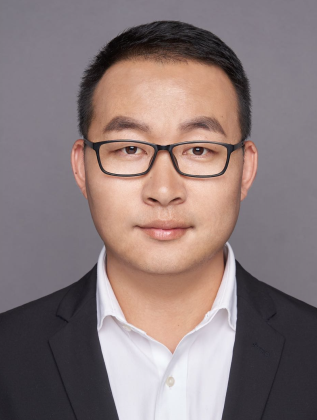-

魏红江
长聘副教授、博士生导师。
研究方向:MRI定量成像,深度学习磁共振重建等。在Science Advances, Brain, Medical Image Analysis, IEEE TMI, Neuroimage等发表论文100余篇,授权专利6项。获海外高层次青年人才计划,主持国自然重大研究计划培育项目、面上项目、青年项目、科技部重点研发计划青年科学家项目、上海科委探索者项目、上海市脑科学与类脑研究中心、企业合作项目等。
实验室网址 http://qmri.sjtu.edu.cn/
教育背景
2004-2008 哈尔滨工业大学
2008-2010 哈尔滨工业大学
2010-2014 法国里昂大学
工作经历
2014-2016 美国杜克大学
2016-2018 美国加州大学伯克利分校
2018- 至今 上海交通大学
研究方向
1.快速、定量、多模态一体化磁共振成像
MRI多定量成像技术在脑科学研究及疾病早期诊断上发挥着重要作用,然而,3D高分辨多模态定量MRI往往需要多次扫描,扫描时间长导致临床不适用。我们提出了3D全脑高分辨多定量参数一体化采集MRI新序列,8-9分钟内可以完成全脑、3D、亚毫米级多定量参数一体化成像,包含T1mapping、T2mapping、T1w、T2w、T2*、QSM、QSM+、QSM-、SWI、B0场、PD、FLAIR等多模态影像,相比于原有采集的总时间1小时左右而言,极大的提高了成像效率。该技术可进一步赋能磁共振快速智能成像。
2. 深度学习磁共振快速重建算法
我们在国际上率先提出了基于隐式神经表达深度学习方法的磁共振快速成像重建上,相比于现有深度学习方法可以不需要训练样本,可以从高度稀疏的k-space中重建高质量的MRI影像。作为一种连续表示,神经辐射场有望获得“无限”分辨率超分辨脑影像。
3. 定量磁共振(QSM,STI)脑成像
定量磁化率成像(Quantitative Susceptibility Mapping, QSM)是一种新型的用于定量组织中磁化率分布的技术。针对QSM本身重建算法挑战,开发了一系列磁化率算法,解决了QSM影像数据的重建是病态逆问题,使得QSM定量精度大大提升。突破了磁共振成像技术瓶颈,开发亚体素QSM磁共振成像新技术。为脑结构精准定量、脑区精准分割、脑图谱构建及相关脑疾病的早期检测提供技术手段。
科研项目
1.科技部重点研发计划青年科学家项目,2024.12-2027.11,主持
2.国家自然基金面上项目,2025.1-2028.12,主持
3.国家自然基金重大研究计划培育项目,2020.1-2022.12,主持
4. 国家自然基金青年项目,2020.1-2022.12,主持
5. 上海市科委"探索者"项目,2023.6-2026.5,主持
6. 上海脑科学类脑中心,2020.1-2022.12,主持
7. 上海交通大学医工交叉基金项目转化基金,2023.1-2025.12
8. 上海交通大学医工交叉基金项目STAR重大项目,2023.1-2025.12
代表性论文专著
Selected publications
-
Li Z#, Liu Q#, Xu T, Zhang M, Li L, Chen Z, Tang Y, Jiang L, Lu Y, Yan F, Zhang Y, Xu J*, Wei H*. Paramagnetic susceptibility measured by magnetic resonance imaging as an in vivo biomarker for iron pathology in epilepsy. Science Advances. 2025, 11(12).
-
Wu L, Wang L*, Deng Z, Zhu Y, Wei H*. Replace2Self: Self-Supervised Denoising based on Voxel Replacing and Image Mixing for Diffusion MRI. IEEE TMI. 2025.
-
Lao G, Feng R, Qi H, Lv Z, Liu Q, Liu C, Zhang Y, Wei H*. Coordinate-based neural representation enabling zero-shot learning for fast 3D multiparametric quantitative MRI. Medical Image Analysis. 2025.
-
Chen L, Tian X, Wu J, Feng R, Lao G, Zhang Y, Liao H, Wei H*. Joint Coil Sensitivity and Motion Correction in Parallel MRI with a Self-Calibrating Score-Based Diffusion Model. Medical Image Analysis. 2025.
-
Feng J, Feng R, Liu C, Zhang Y, Wei H*. Spatiotemporal implicit neural representation for unsupervised dynamic MRI reconstruction. IEEE TMI. 2025.
-
Chu J, Du C, Lin X, Zhang X, Wang L, Zhang Y, Wei H*. Highly Accelerated MRI via Implicit Neural Representation Guided Posterior Sampling of Diffusion Models. Medical Image Analysis. 2024.
-
Chen L, Tian X, Wu J, Lao G, Zhang Y, Wei H*. COLLATOR: Consistent Spatial-Temporal Longitudinal Atlas Construction via Implicit Neural Representation. Medical Image Analysis. 2024.
-
Zhang M, Feng R, Li Z, Feng J, Wu Q, Zhang Z, Liu C, Zhang Y, Wei H*. A subject-specific unsupervised deep learning method for quantitative susceptibility mapping using implicit neural representation. Medical Image Analysis. 2024.
-
Yao J, Li Z, Zhou Z, Wang Z*, Wei H*, He H*. Distinct regional vulnerability to Aβ and iron accumulation in post mortem AD brains. Alzheimers&Dement. 2024. (IF 13.0)
-
Feng R, Wu Q, Wei H*. IMJENSE: Scan-specific Implicit Representation for Joint Coil Sensitivity and Image Estimation in Parallel MRI. IEEE TMI. 2024.
-
Chen M#, Wang Y#, Shi Y, Jin C, Wei H*. Brain Age Prediction Based on Quantitative Susceptibility Mapping Using the Segmentation Transformer. IEEE J Biomed Health Inform. 2024 Feb;28(2):1012-1021.
-
Li Z, Feng R, Wei H*. APART-QSM: An improved sub-voxel quantitative susceptibility mapping for susceptibility source separation using an iterative data fitting method. Neuroimage. 2023 Apr 29;274:120148.
-
Feng R, Cao S, Wei H*. An improved asymmetric susceptibility tensor imaging model with frequency offset correction. Magnetic Resonance in Medicine, 2023,89(2):828-844.
-
Shi Y, Feng R, Wei H*. Towards in vivo ground truth susceptibility for single-orientation deep learning QSM: a multi-orientation gradient-echo MRI dataset. Neuroimage. 2022 Aug.
-
Shi Y, Cao S, Wei H*. Regularized Asymmetric Susceptibility Tensor Imaging in the Human Brain in vivo. IEEE J Biomed Health Inform. 2022 Jun 14; doi: 10.1109/JBHI.2022.3182969.
-
Wu J, Sun T, Wei H*. Age-specific structural fetal brain atlases construction and cortical development quantification for chinese population. Neuroimage, 2021. 241:118412.
-
Feng R, Zhao J, Wei H*. MoDL-QSM: Model-based Deep Learning for Quantitative Susceptibility Mapping. Neuroimage, 2021.240:118376.
-
Zhou L, Li G, Li B*, Wei H*, Liu J*. Increased free-water in the substantia nigra in idiopathic REM sleep behaviour disorder. Brain, 2021,144(5):1488-1497.
-
Wei H*, et al. Learning-based Single-step quantitative susceptibility mapping reconstruction without brain extraction. Neuroimage, 2019, 202.116064.
-
Wei H, et al. MRI Gradient-Echo Phase Contrast of the Brain at Ultra-Short TE with Off-resonance Saturation. Neuroimage, 2018, 175:1-11.
-
Wei H, et al. Imaging whole-brain cytoarchitecture of mouse with MRI-based quantitative susceptibility mapping. Neuroimage, 2016, 137:107-15.
-
Wei H, et al. Free-breathing diffusion tensor imaging and tractography of the human heart in healthy volunteers using wavelet-based image fusion. IEEE Trans on Medical Imaging, 2015, 34(1): 306-316.
-
Wei H*, et al. Assessment of cardiac motion effects on the fiber architecture of the human heart in vivo. IEEE Trans on Medical Imaging, 2013, 32(10): 1928-1938.
-
Wei H, et al. Investigating Magnetic Susceptibility of Human Knee Joint at 7 Tesla. Magnetic Resonance in Medicine, 2017, 78(5):1933-43. MRM highlights
教学工作
1. 生物医学信号与系统(2)(本科三年级,秋季学期)
2. 定量磁共振成像与脑科学(研究生,春季学期)
软件版权登记及专利
-
魏红江; 定量磁化率成像重建方法及系统、存储介质及终端;2020-05-20, 中国, CN202010430561
-
魏红江; 石虞婷;脑组织自由水成像重建方法及系统、存储介质及终端;2020-09-22, 中国, CN202010997163
-
魏红江; 张明;骨骼组织定量成像方法、系统、存储介质及终端;2020.12.23,中国,CN202012230267880
-
魏红江; 冯瑞明;石虞婷;冯颉;基于物理模型的定量磁化率成像重建方法及系统、存储介质及终端;2020-12-10, 中国, CN2020121300229570
学术兼职
IEEE Journal of Biomedical and Health Informatics 副主编
NeuroImage 副主编
Scientific Reports 副主编
Aging and Diseases 青年编委
MED-X 青年编委
《生物医学工程进展》青年编委
荣誉奖励
-
指导研究生获2025届 上海市优秀毕业生
-
2022年度上海交通大学 优秀班主任
-
指导研究生获得2023届 上海市优秀毕业生
-
指导博士、硕士研究生3人次获得2022、2023、2024年研究生国家奖学金
-
指导学生获得2023大学生”互联网+“ 上海市银奖
-
指导学生获得2023大学生”互联网+“ 全国金奖
-
指导学生获得2024大学生”互联网+“ 全国金奖
-
主讲课程《生物医学信号与系统2》校一流课程
-
《数字信号处理》上海交通大学出版社 主编
联系方式
邮箱地址:hongjiang.wei@sjtu.edu.cn
联系电话:021-62932050
办公地址:徐汇MED-X研究院南315室
网址: http://qmri.sjtu.edu.cn/
